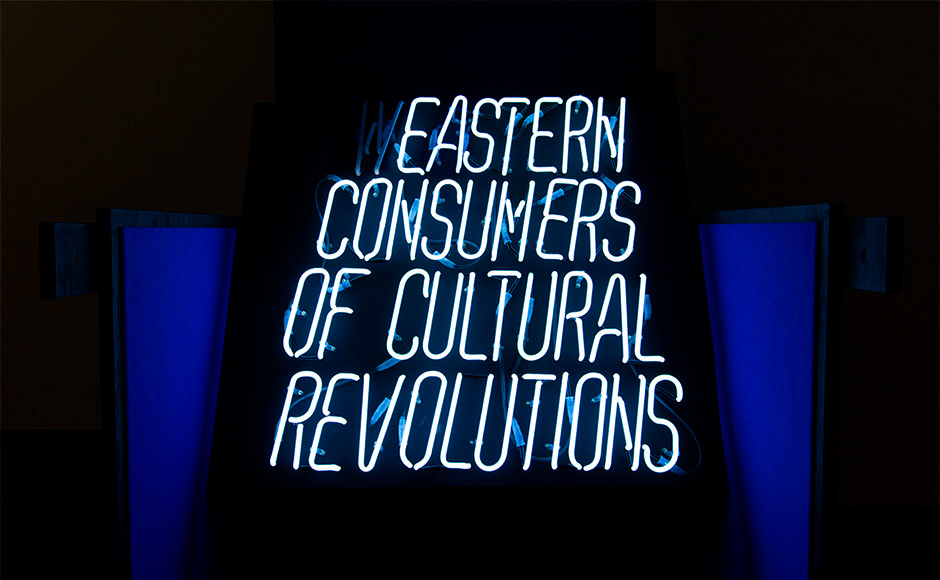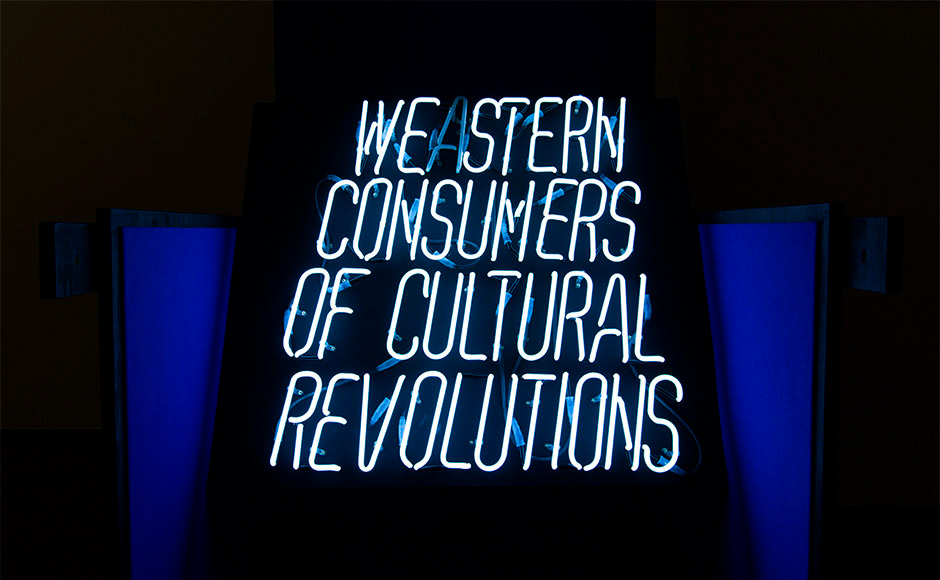Tour group exhibition:
ID:
E17.17--23
E18.7-8,
E19.7,
E19.11
E17.17--23
E18.7-8,
E19.7,
E19.11
Title:
Border
Tour:
2017 — 2019
May 16 – April 15, 2019
Hay Art Cultural Center, Yerevan, Armenia
January 15 – February 15, 2019
House of Youth, Tashkent, Uzbekistan
September 20 – October 16, 2018
A. Kasteyev State Art Museum of Kazakhstan, Alma-Ata, Kazakhstan
May 17 – July 1, 2018
National Centre for Contemporary Arts, Yekaterinburg, Russia
November 25, 2017 – April 8, 2018
Hartware MediaKunstVerein HMKV, Dortmund, Germany
October 13 – November 6, 2017
Korpus, Minsk, Belarus
August 30 – September 21, 2017
Historical Museum Tbilisi, Tbilisi, Georgia
June 20 – July 25, 2017
Art center Plivka, Kyiv, Ukraine
April 22 – May 28, 2017
Krasnoyarsk Museum Center, Krasnoyarsk, Russia
March 16 – April 11, 2017
ARTPLAY SPB, Saint Petersburg, Russia
February 1 – 26, 2017
MMOMA: Zurab Tsereteli Gallery of Arts, Moscow, Russia
Curators:
Inke Arns, Thibaut de Ruyter
Artists:
Umida Ahmedova & Oleg Karpov (Tashkent, Uzbekistan), Alisa Berger (Cologne, Germany), Viron Erol Vert (Berlin, Germany), Aytegin Djumailiyev (Bishkek, Kyrgyzstan), Natalya Dyu (Almaty, Kazakhstan), Saule Dyussenbina (Almaty, Kazakhstan), Hamlet Hovsepian (Ashnak, Armenia), Katya Isaeva (Moscow, Russia), Olga Jitlina (Saint Petersburg, Russia), Anton Karmanov (Novosibirsk, Russia), «Khinkali Juice» / Sophia Tabatadze & Nadia Tsulukidze (Georgia), Alina Kopytsa (Kiev, Ukraine), Gaisha Madanova (Almaty, Kazakhstan / Munich, Germany), Taus Makhatcheva (Moscow, Russia), Eleonore de Montesquiou (Berlin, Germany), Stanislaw Mucha (Berlin, Germany), Marat Raiymkulov (Bishkek, Kyrgyzstan), Alla Rumyantseva & Alexey Rumyantsev (Dushanbe, Tajikistan), Sergey Shabohin (Minsk, Belarus), Alexander Ugay (Almaty, Kazakhstan), Farhad Farzaliyev (Baku, Azerbaijan), «Where Dogs Run» (Yekaterinburg, Russia), Anastasiia (Tasia) Zhyvkova (Kiev, Ukraine)
Work:
Neon installation We are Stern Consumers of Cultural Revolutions
Explication:
Where does Europe end and where does Asia begin? What do borders influence and who draws them? These are the central questions of the new exhibition project «The Border» staged by the Goethe-Institut in conjunction with its partners from Eastern Europe, Germany and Central Asia and scheduled for several years. The participants include young artists from sixteen cities and eleven countries in Europe and Asia. The exhibition opens in Moscow on 31 January, 2017 whence it will travel to Saint Petersburg, Krasnoyarsk, Kiev, Tbilisi, Minsk and Dortmund, and in 2018, it will continue its journey to Central Asia.
The exhibition project «The Border» explores and reflects upon borders and the origin of borders of various kinds: as territorial exclusions or, conversely, inclusions; as cultural, personal or social dividing lines; as an instrument with which to distinguish between «us» and «them» which actually generates this dichotomy in the first place. Thus the word «border» should be taken as a metaphor, as a conventional, received image, which is subject to change — a pressing issue for Russia and the former Soviet republics, as well as for Germany and Europe. The geographical and cultural border between Europe and Asia is the topical thread running through the exhibition. The project approaches these topics from an artistic point of view and cultural dimension: «Our aim is to promote the most diversified analysis of processes and motives of and reasons for the appearance of borders,» states Astrid Wege, Head of Cultural Programmes at the Goethe-Institut, Moscow.
The project focuses on the young generation of artists who, starting from 2017, will present their insights into and reflections upon the matter at the travelling exhibition in Eastern Europe, Russia, Central Asia and Germany. In her series of photographs «The Edges of Gilea», Anastasiia Zhyvkova explores three natural «cordons» in the South of her homeland in order to illustrate the abstract notion of «border» using wholly visual means. The group «Where Dogs Run» (founded in Yekaterinburg in 2000) turns to the subject of temporal borders. The smallpox vaccination scar is a physical mark or emblem of every person who grew up in the USSR. People belonging to the younger, «smooth-armed», generation appear to live on the other side of the border, as if they were a different biological species. The electro-mechanical theatre «Phobia of the Other» will demonstrate how these distinctive marks were made. Olga Jitlina, together with a group of artists and migrant workers from different countries in the post-Soviet space, searches for common cultural traits. In her work «Nasreddin in Russia», she explores the binding, unlimited power of humour. Can laughter, at least temporarily, make people forget about the things that divide them? Can humour provide protection from racial prejudice? The notion of freedom plays a crucial role in another work — «All Borders Are Within Us» by Viron Erol Vert. The work takes the form of a headscarf with a women’s hairstyle printed on either side. When a woman dons this headscarf, she «tries on» one of these hairstyles, though her head remains covered. Thus, it suggests a solution for Muslim women (or non-Muslim women in Muslim countries) to the necessity of covering their heads. The installation «100 Pialas» by Katya Isaeva is a kind of cultural research conducted on the basis of one artefact. In the Soviet era, a trip to Central Asia was one of the few possibilities to get acquainted with another culture; people willingly brought pialas as an exotic souvenir. Each object has its own story, and together they constitute an allegorical narrative about cross-cultural interaction. Something like cultural «field» research underlies the work «19 a Day» by Taus Makhatcheva who, accompanied by the wedding photographer Shamil Gadjidadayev, visited — uninvited — nineteen random weddings in Makhachkala within a day. The artist congratulated the newlyweds respectively, danced, ate and took stereotypical wedding photographs under the professional supervision of her assistant.
Throughout the exhibition’s itinerary, a series of complementary events will take place involving the participation of local specialists and experts from Germany. The exhibition is curated by Inke Arns, Director of the HMKV (the platform for the production, presentation and communication of contemporary and experimental [media] art), as well as Thibaut de Ruyter, Curator and Art Critic from Berlin, Germany.
The exhibition project «The Border» explores and reflects upon borders and the origin of borders of various kinds: as territorial exclusions or, conversely, inclusions; as cultural, personal or social dividing lines; as an instrument with which to distinguish between «us» and «them» which actually generates this dichotomy in the first place. Thus the word «border» should be taken as a metaphor, as a conventional, received image, which is subject to change — a pressing issue for Russia and the former Soviet republics, as well as for Germany and Europe. The geographical and cultural border between Europe and Asia is the topical thread running through the exhibition. The project approaches these topics from an artistic point of view and cultural dimension: «Our aim is to promote the most diversified analysis of processes and motives of and reasons for the appearance of borders,» states Astrid Wege, Head of Cultural Programmes at the Goethe-Institut, Moscow.
The project focuses on the young generation of artists who, starting from 2017, will present their insights into and reflections upon the matter at the travelling exhibition in Eastern Europe, Russia, Central Asia and Germany. In her series of photographs «The Edges of Gilea», Anastasiia Zhyvkova explores three natural «cordons» in the South of her homeland in order to illustrate the abstract notion of «border» using wholly visual means. The group «Where Dogs Run» (founded in Yekaterinburg in 2000) turns to the subject of temporal borders. The smallpox vaccination scar is a physical mark or emblem of every person who grew up in the USSR. People belonging to the younger, «smooth-armed», generation appear to live on the other side of the border, as if they were a different biological species. The electro-mechanical theatre «Phobia of the Other» will demonstrate how these distinctive marks were made. Olga Jitlina, together with a group of artists and migrant workers from different countries in the post-Soviet space, searches for common cultural traits. In her work «Nasreddin in Russia», she explores the binding, unlimited power of humour. Can laughter, at least temporarily, make people forget about the things that divide them? Can humour provide protection from racial prejudice? The notion of freedom plays a crucial role in another work — «All Borders Are Within Us» by Viron Erol Vert. The work takes the form of a headscarf with a women’s hairstyle printed on either side. When a woman dons this headscarf, she «tries on» one of these hairstyles, though her head remains covered. Thus, it suggests a solution for Muslim women (or non-Muslim women in Muslim countries) to the necessity of covering their heads. The installation «100 Pialas» by Katya Isaeva is a kind of cultural research conducted on the basis of one artefact. In the Soviet era, a trip to Central Asia was one of the few possibilities to get acquainted with another culture; people willingly brought pialas as an exotic souvenir. Each object has its own story, and together they constitute an allegorical narrative about cross-cultural interaction. Something like cultural «field» research underlies the work «19 a Day» by Taus Makhatcheva who, accompanied by the wedding photographer Shamil Gadjidadayev, visited — uninvited — nineteen random weddings in Makhachkala within a day. The artist congratulated the newlyweds respectively, danced, ate and took stereotypical wedding photographs under the professional supervision of her assistant.
Throughout the exhibition’s itinerary, a series of complementary events will take place involving the participation of local specialists and experts from Germany. The exhibition is curated by Inke Arns, Director of the HMKV (the platform for the production, presentation and communication of contemporary and experimental [media] art), as well as Thibaut de Ruyter, Curator and Art Critic from Berlin, Germany.
Organizer:
Goethe Institute
Link:

